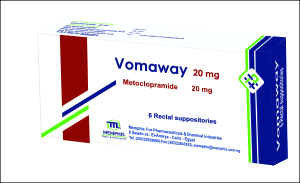TRADE NAME: Vomaway rectal suppository For adult use only and not to be used in children)) GENERIC NAME: Metoclopramide COMPOSITION: Each suppository contains: Active ingredient: Metoclopramide 20 mg : Excipients Hard fat PHARMACEUTICAL FORM: Rectal suppository. INDICATIONS: - In adults, metoclopramide remains indicated for prevention of post-operative nausea and vomiting (PONV), radiotherapy-induced nausea and vomiting and delayed (but not acute) chemotherapy-induced nausea and vomiting, and for symptomatic treatment of nausea and vomiting including that associated with acute migraine (where it may also be used to improve absorption of oral analgesics). DOSAGE AND ADMINISTRATION: Nausea and vomiting: -For adults: the maximum dose in 24 hours is 0.5 mg per kg body weight; the usual dose is 10 mg up to 3 times daily. CONTRAINDICATIONS: - Hypersensitivity to metoclopramide or any of the components. - Gastrointestinal hemorrhage, mechanical obstruction or gastrointestinal Perforation for which the stimulation of gastrointestinal motility constitutes a risk. - History of neuroleptic or metoclopramide - induced tardive dyskinesia. - Confirmed or suspected pheochromocytoma, because of the risk of severe hypertension episodes. - Combination with levodopa because of a mutual antagonism. WARNINGS AND PRECAUTIONS: - Extrapyramidal disorders may occur, particularly in young adults. These adverse reactions resolve completely after treatment discontinuation. A symptomatic treatment may be necessary (benzodiazepines and/or anticholinergic anti-parkinsonian drugs in adults). - In the case of vomiting with rejection of the dose , respect the specified interval before re-administering metoclopramide. - Metoclopramide is not recommended in epileptic patients as benzamide may decrease the epileptic threshold. - In patients with renal or hepatic impairment a dose reduction is recommended. - As with neuroleptics, Neuroleptic Malignant Syndrome (NMS)characterized by hyperthermia, extrapyramidal disorders , autonomic nervous instability and elevated CPK, may occur. Therefore cautions have to be taken if fever, one of the symptoms of NMS, occurs and metoclopramide has to be stopped if a NMS is suspected. - Methemoglobinemia, which could be related to NADH cytochrome b5 reductase deficiency, has been reported. In such cases, metoclopramide should be immediately and permanently discontinued and appropriate measures initiated. - In order to minimise the risks of neurological and other adverse reactions, metoclopramide is now only licensed for short-term use (up to 5 days). It should no longer be used in chronic conditions such as gastroparesis, dyspepsia and gastro-oesophageal reflux disease, nor as an adjunct in surgical and radiological procedures. - Given very rare reports of serious cardiovascular reactions associated with metoclopramide, particularly via the intravenous route, special care should be taken in populations likely to be at increased risk, including the elderly, patients with cardiac conduction disturbances, uncorrected electrolyte imbalance or bradycardia, and those taking other drugs known to prolong QT interval. - Patients who are currently taking regular metoclopramide should have their treatment reviewed at a routine (non-urgent) medical appointment. DRUG INTERACTIONS: Contraindicated combinations: Levodopa: Levodopa and metoclopramide have a mutual antagonism. Combination to be avoided: Alcohol: alcohol potentiates the sedative effect of metoclopramide. Combination to be taken into account: .Anticholinergics and morphine derivatives: Anticholinergics and morphine derivatives have both a mutual antagonism with metoclopramide on the digestive tract motility. .CNS depressants(morphine derivatives, hypnotics, anxiolytics, sedative H1antihistamines, sedative antidepressants, barbiturates, clonidine and related): Sedative effects of CNS depressants and metoclopramide are potentiated. .Neuroleptics: metoclopramide may have an additive effect with neuroleptics on the occurrence of extrapyramidal disorders. .Digoxin: metoclopramide decreases digoxin bioavailability. Careful monitoring of digoxin plasma concentration is required. .Cyclosporine: metoclopramide increases cyclosporine bioavailability. Careful monitoring of cyclosporine plasma concentration is required. PREGNANCY AND LACTATION: Animal studies have not demonstrated any teratogenic effect. In the absence of a teratogenic effect in animals , a malformative effect in humans is not anticipated. In humans, a quite wide exposure of pregnant women has not revealed malformation or fetotoxicity. However, as any drug, metoclopramide should be used only if needed during pregnancy. Metoclopramide passes into breast milk. In consequence, breast-feeding should be avoided. EFFECTS ON ABILITY TO DRIVE AND USE MACHINES: Drowsiness may occur following administration of metoclopramide, potentiated by CNS depressants, alcohol, the ability to drive vehicles or operate machinery can be impaired. SIDE EFFECTS: - Central nervous system and psychiatric disorders: * Extrapyramidal symptoms may occur, particularly in young adults, or when doses are exceeded , even following administration of a single dose of the drug: acute dystonia and dyskinesia, parkinsonian syndrome, akathisia . *Chronic use of metoclopramide has been linked to tardive dyskinesia, which may include involuntary and repetitive movements of the body, even after the drugs are no longer taken. *Drowsiness. *Depressive tendency. *Very rare cases of seizures and neuroleptic malignant syndrome have been reported. - Gastro-intestinal disorders: Diarrhea - Hematological disorders: Very rare cases of methemoglobinemia which could be related to NADH cytochrome b5 reductase deficiency have been reported, particularly in neonates. - Endocrine disorders: Endocrine disorders during prolonged treatment in relation with hyperprolactinemia (amenorrhea, galactorrhea, gynecomastia). - Body as a whole: - *Allergic reactions including anaphylaxis. *Asthenia.
